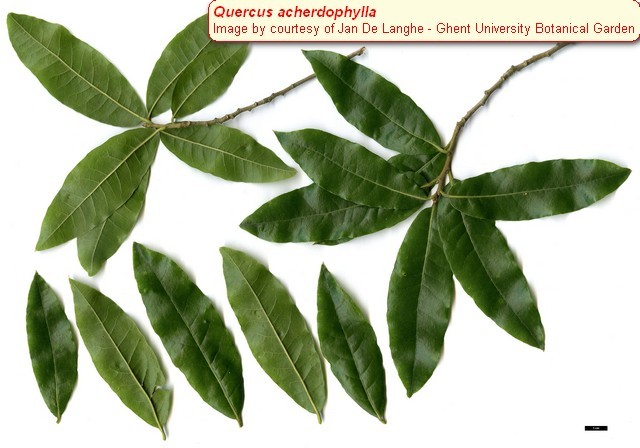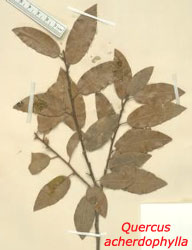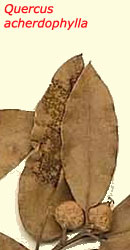| Quercus acherdophylla | |
| Author |
Trel. 1924 Mem. Natl. Acad. Sci. 20: 183 Diagnosis here |
| Synonyms | |
| Local names | |
| Range | Mexico, Sierra Madre Oriental (Hidalgo, Puebla, Oaxaca, Veracruz); 1500-2500 m; |
| Growth habit | to 20 m tall; trunk to 1.5 m in diameter; |
| Leaves | 3-8 cm X 1-3; deciduous (or somewhat evergreen in cultivation); chartaceous to subcoriaceous; elliptic, elliptic-lanceolate or oblong, ca 3 times longer than wide; apex acute to rounded, bristle-tipped; base rounded or obtuse or cuneate; margin entire, thick, flat or slightly crispate and wavy, without teeth; dark lustrous green above, hairless or with few stellate and multiradiate trichomes on the midrib; dull beneath, with tufts of multiradiate trichomes at axils and along midrib, especially near base, which diminishes, remaining withish axillary tufts; 8-16 vein pairs, flat or slightly impressed adaxially, prominent beneath; epidermis slightly papillose; petiole 3-5 mm long, becoming hairless; young leaves hairy, attractive bronze; |
| Flowers | in April; |
| Fruits | acorn subglobose, 0.6-1 cm in diameter, mucronate, glabrous; singly on a short 3-11 mm long peduncle; cup shallow, enclosing 1/2 or 1/3 of nut, with appressed, glabrescent scales; maturing in 1 year in October-November; |
|
Bark, twigs and |
bark smooth at first, becoming furrowed; twig 1-1.5 mm thick, slender but stiff, glabrescent, dull brown, with small lenticels; bud ovoid, hairless, amber to grey, scales ovate and ciliate at margin, 1.5-3.5 mm long; |
| Hardiness zone, habitat | hardy zone 7-8; fast growing; moist oak forest, cloud forests and riparian forests; |
| Miscellaneous | -- A. Camus = n° 369; -- Sub-genus Quercus, section Lobatae, sub-section Erythromexicanae; -- For several Authors in Central America, and for The Plant List 2013, it is a synonym of Q.salicifolia. -- Possible confusion with Q. laurina and Q. affinis especially when they lack fruits, as they all present lanceolate and glabrescent leaves; however Q.acherdophylla can be easily separated based on its annual fruits, chartaceous to semicoriaceus blades, entire blade margin and acute to rounded apex; whereas Q. laurina and Q. affinis have fruits that mature in two years, coriaceous blades, the blade margin commonly is aristate-dentate near the apex, and the apex usually is acute. |
| Subspecies and varieties |
|
| Pictures |
More pictures HERE
|


